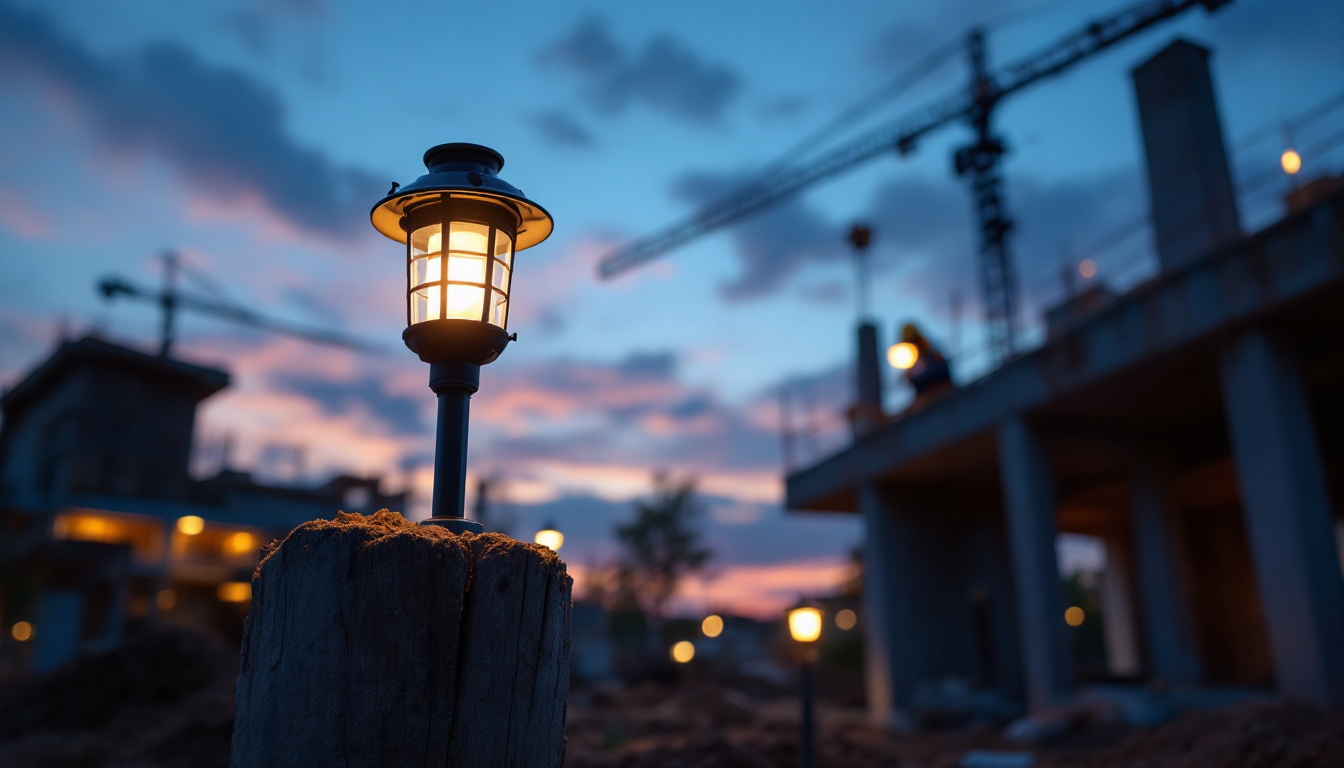
In the realm of commercial outdoor lighting, contractors face a unique set of challenges and opportunities. The right lighting can enhance safety, improve aesthetics, and boost functionality for various outdoor spaces. This guide aims to equip lighting contractors with essential knowledge about commercial outdoor lights, covering types, applications, installation tips, and maintenance strategies.
commercial outdoor lighting serves multiple purposes, from illuminating pathways and parking lots to accentuating architectural features. Understanding the various types of outdoor lighting is crucial for contractors to make informed decisions that meet the specific needs of their clients. Properly designed outdoor lighting not only enhances the functionality of a space but also contributes to the overall aesthetic and safety of the environment. By considering factors such as brightness, energy efficiency, and placement, contractors can create a well-lit atmosphere that aligns with the client’s vision and operational needs.
There are several types of commercial outdoor lights, each designed for specific applications. Some of the most common types include:
Understanding the applications of different types of outdoor lighting is essential for contractors. Some common applications include:
In addition to these applications, outdoor lighting can also play a significant role in sustainability efforts. Many businesses are now opting for energy-efficient LED lighting solutions that not only reduce electricity costs but also have a lower environmental impact. These advancements in technology allow for smart lighting systems that can be controlled remotely, programmed to adjust based on natural light levels, and even integrated with renewable energy sources. As the demand for eco-friendly solutions grows, contractors must stay informed about the latest innovations in outdoor lighting to provide clients with the best options available.
Selecting the appropriate lighting solution involves considering various factors, including the environment, the specific needs of the space, and energy efficiency. Here are some key considerations for lighting contractors.
The environment plays a significant role in determining the type of lighting to use. For instance, coastal areas may require corrosion-resistant fixtures, while regions prone to severe weather may benefit from robust, weatherproof designs. Understanding local climate conditions can guide the selection of materials and fixtures. Additionally, it’s essential to consider the surrounding landscape and wildlife. For example, in areas with significant nocturnal wildlife, using fixtures that minimize light pollution can help preserve the natural habitat and maintain the ecological balance.
Every client has unique requirements and preferences. Engaging in thorough discussions with clients about their vision, budget, and specific needs can lead to better project outcomes. This may include considerations such as color temperature, brightness levels, and fixture styles. Moreover, clients may have specific functional needs, such as enhanced security or aesthetic appeal for entertaining spaces. Understanding these nuances can help contractors suggest tailored solutions that not only meet practical requirements but also enhance the overall ambiance of the outdoor area.
With increasing emphasis on sustainability, energy-efficient lighting solutions are becoming more popular. LED fixtures, for example, consume significantly less energy than traditional lighting options and have a longer lifespan. Contractors should be well-versed in the benefits of energy-efficient technologies and how they can contribute to overall project sustainability. Furthermore, integrating smart lighting systems can provide clients with greater control over their energy consumption. These systems can be programmed to adjust brightness based on the time of day or occupancy, thus optimizing energy use and reducing costs while providing convenience and enhancing security.
Proper installation is crucial for ensuring the longevity and effectiveness of outdoor lighting systems. Here are some best practices that lighting contractors should follow.
Before installation, a well-thought-out lighting plan is essential. This involves determining the optimal locations for fixtures to achieve even illumination while minimizing shadows and dark spots. Utilizing lighting design software can aid in visualizing the layout and making adjustments as needed. Additionally, considering the surrounding landscape and architecture can enhance the overall aesthetic appeal. For instance, uplighting trees or architectural features can create dramatic effects while providing functional light. Engaging with clients during the planning phase can also help align the lighting design with their vision and preferences.
When installing outdoor lighting, electrical safety is paramount. Contractors should ensure that all wiring is rated for outdoor use and protected from moisture. Additionally, using proper circuit breakers and ensuring that the installation complies with local electrical codes is essential for safety and reliability. It’s also advisable to incorporate timers or smart controls that allow for automated operation of the lighting system. This not only enhances convenience but can also lead to energy savings, as lights can be programmed to turn on and off at specific times, reducing unnecessary usage during daylight hours or when the property is unoccupied.
After installation, thorough testing is necessary to ensure that all fixtures function correctly and provide the desired level of illumination. Adjustments may be needed to optimize light distribution and achieve the intended aesthetic effect. This step is crucial to ensure client satisfaction and safety. During this phase, contractors should also assess the lighting from various vantage points, both from within the property and from the street, to ensure that the lighting enhances the landscape without causing glare or discomfort to neighbors. Documenting the final settings and configurations can be beneficial for future maintenance and adjustments, ensuring that the lighting system remains effective over time.
Regular maintenance is key to prolonging the life of outdoor lighting systems and ensuring their effectiveness. Contractors should be aware of various maintenance strategies to recommend to their clients.
Conducting routine inspections helps identify any issues early on. This includes checking for burnt-out bulbs, damaged fixtures, and any signs of corrosion or wear. Regular inspections can prevent minor issues from escalating into costly repairs.
Outdoor lighting fixtures can accumulate dirt, debris, and grime, which can diminish their effectiveness. Regular cleaning ensures that fixtures remain bright and functional. Contractors should advise clients on the best cleaning methods and materials to use, ensuring that they do not damage the fixtures.
As technology advances, older lighting systems may become outdated. Contractors should stay informed about new products and technologies that can enhance performance and efficiency. Encouraging clients to upgrade their systems can lead to improved lighting quality and energy savings.
The lighting industry is constantly evolving, with new trends emerging regularly. Staying informed about these trends can help contractors offer cutting-edge solutions to their clients.
Smart lighting technology is gaining traction in commercial outdoor lighting. These systems allow for remote control, automation, and integration with other smart building systems. Contractors should explore options for smart lighting solutions that enhance convenience and efficiency for clients.
With a growing focus on sustainability, solar-powered outdoor lighting is becoming increasingly popular. These systems harness solar energy, reducing reliance on the grid and lowering energy costs. Contractors should consider incorporating solar options into their offerings, particularly for clients interested in eco-friendly solutions.
Beyond functional lighting, there is a rising demand for architectural and decorative outdoor lighting. These solutions not only illuminate spaces but also enhance the aesthetic appeal of buildings and landscapes. Contractors should be prepared to offer creative lighting designs that align with their clients’ visions.
Commercial outdoor lighting is a multifaceted field that requires a comprehensive understanding of various types of lights, installation practices, and maintenance strategies. By staying informed about trends and advancements in the industry, lighting contractors can provide valuable solutions that meet their clients’ needs. The right outdoor lighting not only enhances safety and functionality but also contributes to the overall aesthetic appeal of commercial properties.
As the demand for effective outdoor lighting continues to grow, contractors who prioritize quality, efficiency, and innovation will stand out in the competitive landscape. By following the guidelines outlined in this ultimate guide, lighting contractors can elevate their services and ensure successful project outcomes.
Ready to take your lighting projects to the next level? At LumenWholesale, we provide lighting contractors like you with the highest quality, spec-grade commercial outdoor lights at unbeatable wholesale prices. Say goodbye to local distributor markups and hello to a vast selection of reliable, high-performance lighting that meets the highest industry standards. With free shipping on bulk orders, we ensure you get the premium lighting you need at the best value — no hidden fees, no compromises. Elevate your service offerings and delight your clients by choosing LumenWholesale for your lighting solutions. Discover the perfect blend of quality, affordability, and convenience today by visiting our selection at Wholesale Lighting at the Best Value.

Discover the ultimate checklist for lighting professionals focusing on outlet plugs.

Explore how island light fixtures are transforming the approach of lighting contractors, enhancing both aesthetics and functionality in modern projects.

Discover why solar lanterns are becoming a crucial tool for lighting contractors in sustainable projects.

Discover how LED flood lights are revolutionizing the lighting industry and boosting success for contractors.